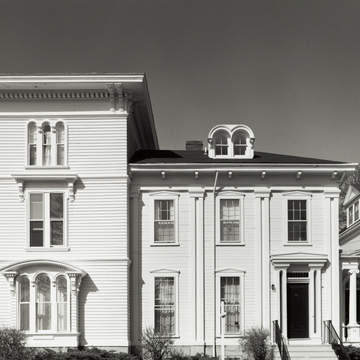And here a full-blown Italian villa, the dominating tower at the corner making a virtual wing of the body of the house. Three stories of tall, narrow windows rise in the tower, providing a display of round-arched and rectangular openings hooded by segmental and table projections on brackets, all climaxed by a deep, bracketed overhang at the eaves. The entrance porch to the adjacent office demonstrates how the choice of essentially eclectic examples from the past (like the Italian villa, which mixed classical, medieval, and vernacular elements) loosened the classical hold of the Greek Revival. The canonical entablature supported by Ionic columns is scooped into a bracketed arch; classical pediments tend toward shading hoods; the expected classical dentil molding under the cornice becomes a rope molding; the entrance is an elegant but nonclassical arch. The more exotic aspects of Greek ornament were especially attractive to mid-nineteenth-century taste and anticipated the lavish embellishment of much Victorian design, as suggested by the Egyptoid lushness of the capitals of the Littlefield House and, here, the beautiful acroterion which surmounts the entrance pediment of the office wing. Except only for the Edward King House, the Butler House is the finest extant example of the Italian Villa Style in Newport.
You are here
Butler House
If SAH Archipedia has been useful to you, please consider supporting it.
SAH Archipedia tells the story of the United States through its buildings, landscapes, and cities. This freely available resource empowers the public with authoritative knowledge that deepens their understanding and appreciation of the built environment. But the Society of Architectural Historians, which created SAH Archipedia with University of Virginia Press, needs your support to maintain the high-caliber research, writing, photography, cartography, editing, design, and programming that make SAH Archipedia a trusted online resource available to all who value the history of place, heritage tourism, and learning.














